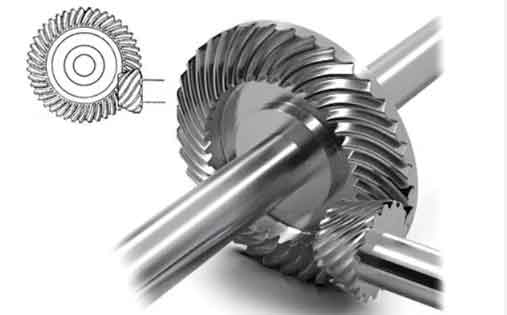Spiral bevel gears are critical components in automotive and aerospace transmission systems. Traditional machining methods face challenges such as low efficiency and material waste. Near-net shape forging technology significantly improves material utilization while enhancing mechanical properties through optimized fiber flow. This study investigates the microstructure evolution of 20CrMnTiH steel spiral bevel gears during multi-stage forging processes and establishes an optimized parameter combination using finite element analysis and response surface methodology.

1. High-Temperature Deformation Behavior of 20CrMnTiH Steel
The flow stress characteristics were determined through isothermal compression tests at 900-1100°C with strain rates of 0.01-5s-1. The constitutive relationship was established using Arrhenius-type equations:
$$Z = \dot{\epsilon} \exp\left(\frac{Q}{RT}\right)$$
$$ \sigma = \frac{1}{\alpha} \ln\left\{\left(\frac{Z}{A}\right)^{1/n} + \left[\left(\frac{Z}{A}\right)^{2/n} + 1\right]^{1/2}\right\} $$
Key material parameters were identified through regression analysis:
| Parameter | Value |
|---|---|
| Activation Energy Q (kJ/mol) | 440.547 |
| Stress multiplier α | 0.009698 |
| Material constant A | 4.174×1018 |
| Stress exponent n | 7.3786 |
2. Forging Process Design for Spiral Bevel Gears
The manufacturing sequence includes four stages: upsetting, punching, ring rolling, and gear forming. Critical process parameters were determined through volume conservation:
$$ V_{billet} = (V_{forging} + V_{flash})(1 + \delta) $$
| Process Stage | Key Parameters |
|---|---|
| Upsetting | Height reduction: 68% |
| Punching | Flash thickness: 7-10mm |
| Ring Rolling | Feed speed: 0.8-1.2mm/s |
| Gear Forming | Mold speed: 150-250mm/s |
3. Microstructure Evolution Analysis
Finite element modeling revealed distinct dynamic recrystallization (DRX) patterns:
$$ X_{DRX} = 1 – \exp\left[-k_d\left(\frac{\epsilon – \epsilon_c}{\epsilon_p}\right)^{n_d}\right] $$
Grain size evolution follows:
$$ d = \left(A_d Z^{-m}\right)^{1/q} $$
| Process Stage | Average Grain Size (μm) | DRX Percentage |
|---|---|---|
| Initial Billet | 45.2 | 0% |
| After Upsetting | 28.7 | 63% |
| After Rolling | 19.9 | 81% |
| Final Gear | 11.8 | 93% |
4. Parameter Optimization Using RSM
A central composite design with four key parameters was implemented:
| Factor | Range |
|---|---|
| Height-Diameter Ratio | 1.5-2.7 |
| Billet Temperature (°C) | 950-1100 |
| Strike Speed (mm/s) | 150-250 |
| Friction Factor | 0.1-0.5 |
The response surface models for grain characteristics were established:
$$ Y_1 = 782.8 – 20.11X_1 – 1.34X_2 + 0.55X_3 + 2.98X_4 + \ldots $$
$$ Y_2 = 4.67 – 0.28X_1 – 0.035X_2 + 0.16X_3 + 0.12X_4 + \ldots $$
Optimization results showed:
| Optimal Parameter | Value |
|---|---|
| Height-Diameter Ratio | 2.34 |
| Billet Temperature | 1025°C |
| Strike Speed | 206mm/s |
| Friction Factor | 0.2 |
5. Experimental Validation
Metallographic analysis confirmed the simulation accuracy:
| Position | Simulated (μm) | Experimental (μm) | Error |
|---|---|---|---|
| Tooth Tip | 14.57 | 15.87 | 8.2% |
| Tooth Root | 11.22 | 12.15 | 7.6% |
| Gear Center | 7.45 | 8.11 | 8.1% |
The optimized spiral bevel gears achieved grain refinement of 28.9% compared with initial parameters, demonstrating significant improvement in microstructure uniformity.
Conclusion
This study establishes a comprehensive methodology for controlling microstructure evolution in spiral bevel gear forging. The integration of thermal-mechanical simulation and response surface optimization provides an effective approach for manufacturing high-performance transmission components. Future work should focus on mold structure optimization and advanced numerical methods to further improve prediction accuracy.
